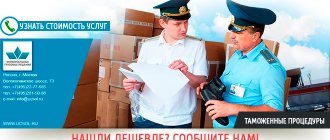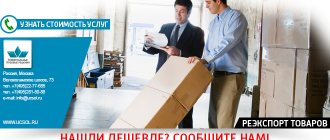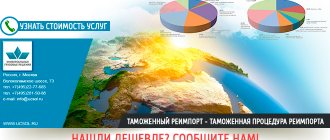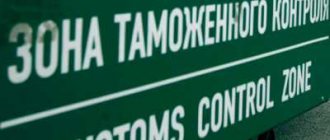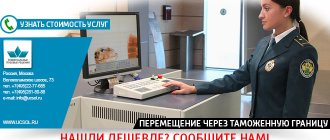Customs duties are mandatory payments for goods crossing the state border. It includes customs duties and fees, taxes, fees for issuing licenses, information, consulting, storage and maintenance of goods, etc.
Payment of customs duties is ensured by measures of state coercion and is a mandatory condition for the export or import of goods.
The main functions performed by customs payments are replenishment of the treasury and state regulation of the economy. Customs authorities exercise strict control over the payment of customs duties.
Deliberate evasion or deliberate actions for the purpose of illegally reducing payment amounts is classified as a crime.
Customs re-import procedure
Home — Articles
Re-import of goods is one of the customs procedures established by the Customs Code of the Customs Union (Article 202), and determines for customs purposes the requirements and conditions for the use and disposal of goods in the customs territory of the union. Re-import is quite widely used in foreign trade operations, since in a number of cases there is a need to re-import goods previously exported from the customs territory of the Customs Union. It should be borne in mind that the current legal framework regulating customs legal relations in re-import is contained in the documents of the Customs Union and national legislation. The rules governing re-import are included in Chapter 39 of the Customs Code of the Customs Union (hereinafter referred to as the Union Customs Code) and Chapter 36 of the Federal Law of November 27, 2010 N 311-FZ “On Customs Regulation in the Russian Federation”.
Reimport in practice is used as a procedure that has independent significance, and as a procedure that completes the action of some other procedures . Thus, the customs export procedure involves the export of goods outside the customs territory of the union with the aim of their permanent location outside the union. At the same time, circumstances may arise that require the return of previously exported goods, for example, non-compliance with the terms of the contract. In this case, re-import can be considered as an independent procedure, since the export procedure ends with the export of goods. The customs procedure for processing outside the customs territory of the Union provides for the export of goods for the purpose of their processing within a specified time frame, with the subsequent re-import of processed products. Thus, the re-import of goods completes the processing procedure outside the customs territory of the union and, from the point of view of customs regulation, is considered as a re-import procedure. The content of the customs procedure for temporary export is the export of goods of the Customs Union using them for a certain time outside the customs territory of the union. The re-importation of such goods into the territory of the Union will be accompanied by a re-import procedure, which completes the temporary export of goods. The import of previously exported goods is possible using the customs procedure for releasing goods for domestic consumption, but in this case import customs duties and taxes would be subject to payment with the need to comply with non-tariff regulation measures, which would not primarily meet the economic interests of participants in foreign trade activities exporting goods. The customs re-import procedure simplifies the conditions for the re-import of goods, freeing the declarant from paying the specified fees and complying with non-tariff regulation measures. In accordance with Article 292 of the Labor Code of the Union, the content of this procedure is the re-importation of goods previously exported from the customs territory of the Union to the specified territory in compliance with the deadlines established by Article 293 of the Labor Code of the Union, without paying import customs duties, taxes and without applying non-tariff regulation measures. Goods placed under the procedure under consideration acquire the status of goods of the Customs Union, with the exception of goods specified in subparagraph 4 of paragraph 1 of Article 293 of the Labor Code of the Union, which are products of processing of goods exported from the customs territory of the union in accordance with paragraph 3 of Article 253 of the Labor Code of the Union. This exception is due to the fact that Article 253 of the Labor Code of the Union provides for the possibility of exporting, in the procedure of processing goods outside the customs territory of the Union, goods placed under the procedure of release for domestic consumption with the provision of benefits for the payment of customs duties and taxes, which is associated with restrictions on the use and disposal of such goods . It should be added that these goods have the status of foreign goods remaining under customs control after their release for domestic consumption. However, this is not an obstacle to their export for the purpose of processing outside the customs territory of the union, as provided for in Article 253 of the Labor Code of the union. The return of such goods in the form of processed products using the re-import procedure does not change their status, i.e. they remain foreign goods, otherwise the change in status would conflict with the conditions for placing goods under the procedure of release for domestic consumption (clause 3 of Article 210 of the Labor Code of the Union). The legal status of goods placed under the re-import procedure is characterized by the fact that they act as goods released for free circulation , i.e. goods are in circulation in the customs territory of the union without prohibitions and restrictions provided for by customs legislation. An important feature of the content of this procedure is, as already indicated, exemption from customs duties, taxes and the application of non-tariff regulation measures. The placement of re-imported goods into re-import is accompanied by a number of conditions, which are contained in Article 293 of the Labor Code of the Union. First of all, this article lists the customs procedures that accompanied the export of goods from the customs territory of the union, which subsequently allow the use of re-import. Such procedures are export; processing in the customs territory, if processed products were exported; temporary export; processing outside the customs territory, if goods are imported that have not been subjected to processing operations, or products of processing of goods that were exported for the purpose of processing for free (warranty) repairs. The placement of goods for re-import is subject to compliance with the deadlines for the return of goods to the customs territory of the union. Goods exported in the export procedure or which were products of processing of goods placed under the processing procedure in the customs territory and then exported in the re-export procedure may be placed under re-import if these goods are placed under this procedure within three years from the day following the day of their movement across the customs border when exported from the customs territory of the union, or within another period established by paragraph 2 of Article 293 of the Labor Code of the union. Paragraph 2 of Article 293 of the Labor Code of the Union provides for the possibility of establishing a period exceeding three years by decision of the Customs Union Commission. In order to implement this provision, the decision of the Customs Union Commission dated September 20, 2010 N 375 “On some issues of the application of customs procedures” identified categories of goods for which the period of placement under the re-import procedure may exceed the period established by the Labor Code of the Union, which includes goods used for construction, industrial production, mining and other similar purposes, as well as goods exported in the export procedure, to ensure the functioning of embassies, consulates and other official representative offices of the member states of the Customs Union outside the customs territory of the union, in respect of which, in accordance with the legislation Member states of the Customs Union decided to extend the period for placing these goods under the re-import procedure. Thus, the Commission's decision defines the purpose of the export of goods. The procedure for extending the period for re-importation of goods in the case under consideration is established by the Federal Law “On Customs Regulation in the Russian Federation” (Article 286). To extend the period, the declarant, no later than 30 days before the day of declaration of goods, sends a reasoned request to the federal executive body authorized in the field of customs affairs, i.e. to the Federal Customs Service. The request must set out the circumstances of the export of goods with the attachment of a customs declaration accompanying the export of goods, as well as documents : 1) confirming the circumstances of the export of goods; 2) indicating the date the goods crossed the customs border of the union; 3) containing information about operations for the repair of goods outside the customs territory of the union, if they were carried out. The request is considered within no more than 30 days, under certain conditions or more, for example when not all necessary documents are submitted. In this case, the request is considered within 15 days from the date of their submission. Noteworthy is the provision of Article 286 of the Law, according to which the decision to extend the period for re-import of goods is made by the head of the structural unit of the Federal Customs Service, whose competence includes issues of application of customs procedures, or the person replacing him. The decision to extend the period must be brought to the attention of the declarant and the customs authority in the region of activity of which the declaration of goods for re-import will be carried out. In this regard, the question arises: which customs authority will be notified of the decision made (RTU, customs, customs post)? In addition to the procedures for export and processing in the customs territory, goods can be exported under the temporary export procedure, in which case they must be imported back within the period of temporary export. Goods placed under the processing procedure outside the customs territory must be imported back within the processing period. Another condition for re-import is that the re-imported goods must be in an unchanged condition, except for changes due to normal wear and tear or natural loss under normal conditions of transportation, storage and use. This condition (constancy of condition) has its own characteristics in relation to goods exported under the temporary export procedure, which allows for other changes when using goods during temporary export. The same condition does not apply to products of processing of goods exported in the processing procedure outside the customs territory of the union for the purpose of free (warranty) repairs, since during repairs the quality of the goods changes, for example, a faulty product is brought to a working condition. A requirement for re-import is the need to submit documents to the customs authority containing information about the circumstances of the export of goods from the customs territory of the union . Such documents are the customs declaration accepted when exporting goods, as well as documents: 1) confirming the circumstances of the export of goods; 2) indicating the date the goods crossed the customs border of the union; 3) containing information about operations for the repair of goods outside the customs territory of the union, if they were carried out. Please note that the list of documents is limited. It seems that the wording “documents confirming the circumstances of the export of goods” will require additional clarification, since questions arise as to what should be understood by such documents: a foreign trade contract, licenses, permits, etc.? An analysis of the conditions for placing goods under the re-import procedure makes it necessary to more carefully consider the requirement that the condition of imported goods remain unchanged. The Labor Code of the Union takes into account only changes caused by natural wear and tear or loss that occurred under normal conditions of use (operation) or transportation and storage. It should be noted that the condition of the goods may change under other circumstances, for example, during loading or unloading, as a result of incorrect actions, the goods were damaged, including to the point of impossibility of operation. Such circumstances may arise before the goods are delivered to a foreign customer, i.e. The supplier becomes obligated to supply new goods or carry out repair operations to restore damaged goods. Damaged goods often must be returned to the supplier, since, depending on the nature of the damage, restoration work in some cases is possible only at the manufacturer of the product. When placing such goods under the re-import regime, it is necessary to maintain immutability, and therefore relevant questions will arise from the customs authorities. Such questions arose when applying Article 235 of the Customs Code of the Russian Federation, which also contained a requirement for immutability in the same wording. The return of damaged goods can be carried out in the mode of release for domestic consumption, which, as a rule, the customs authorities insisted on, but then the payment of customs duties and taxes is necessary, which will lead to additional costs, and compliance with non-tariff regulation measures. It should be noted that the International Convention on the Simplification and Harmonization of Customs Procedures (hereinafter referred to as the Convention) takes into account this circumstance. Standard Rule 4 of Chapter 2 of Special Annex B of the Convention provides that re-importation should not be refused on the grounds that the goods have been used or damaged or have become unusable while abroad, which is in the interests of the manufacturers. A feature of the procedure under consideration is that its declarant may be a person who acted as a declarant in one of the procedures accompanying the export of goods from the customs territory of the union. At the same time, paragraph 4 of Article 293 of the Labor Code of the Union establishes that the customs legislation of the Customs Union may establish cases when another person may act as the declarant of the re-import procedure. One can only speculate why such cases are not listed, but since such a formula is available in the Labor Code of the Union, we can come to the conclusion that they occur, especially since the Convention provides for the possibility of re-importation, even if the goods are re-imported by a person other than the one who exported (Special Annex B, Chapter 2, Standard 3). The Union Customs Code limits the circle of customs authorities to which it is possible to submit a declaration of re-import; such an operation is permitted in a member state of the Customs Union in which they were placed under one of the procedures specified above. As already indicated, re-import is carried out without paying import customs duties and taxes, but at the same time, re-import involves the reimbursement of taxes and interest on them, when the amounts of such taxes in connection with the export of goods were not paid or were returned, as well as amounts of other taxes and subsidies and other amounts not paid or received directly or indirectly as payments, benefits or compensation in connection with the export of goods. For example, when exporting goods, there is an exemption from paying value added tax, there may be some subsidies to support exports paid to the exporter, and reimbursement of part of the cost of paying interest on loans received from credit institutions. Thus, during re-import, the participant in foreign trade activity returns to its original position. The Union Labor Code provides for two procedures for the reimbursement of customs duties, taxes and other payments. Reimbursement of import customs duties, when the amounts of such duties in connection with the export of goods were not paid or were returned, is made in accordance with the international agreement of the member states of the Customs Union. Import customs duties are reimbursed, for example, when products of processing of goods that were previously placed under the processing procedure in the customs territory and exported in the re-export procedure are imported back through re-import. The import of goods for processing in the customs territory of the Union occurs without payment of import customs duties and taxes, subject to the export of processed products, therefore the re-import of processed products entails reimbursement of import customs duties and taxes. Reimbursement of taxes, subsidies and other amounts is made in the manner and under the conditions established by the legislation of the member states of the Customs Union. Article 288 of the Federal Law “On Customs Regulation in the Russian Federation” establishes that upon re-import, the amounts of import customs duties are subject to payment to the account of the Federal Treasury, and in cases established by an international treaty of the member states of the Customs Union, to the account determined by this international treaty, taxes and other amounts that have already been mentioned. Responsibility for payment of these payments rests with the declarant, and the payments in question must be paid before the release of the goods in the re-import procedure. Some goods may be exported under the export procedure with the payment of export customs duties. The return import of such goods involves the return of paid amounts of export duties, which is possible if the goods specified in subparagraph 1 of paragraph 1 of Article 293 of the Labor Code of the Union, i.e. goods placed under the export procedure, and products of processing of goods placed under processing in the customs territory of the Union, exported under the re-export procedure, are placed under re-import no later than six months from the day following the day such goods were placed under the export procedure. It is noteworthy that the calculation of the period begins not from the day the goods cross the customs border, but from the day they are released for export. The content of the provisions governing the re-import procedure raises questions: is it possible to place part of previously exported goods under this procedure, is re-import allowed in relation to goods that have already been placed under any customs procedure after re-importation into the territory of the Union and are not listed in paragraph 1 of Article 293 Union Labor Code, for example, those placed under the procedure of a customs warehouse or duty-free shop?
Customs regimes/procedures, Customs Union
Duty-free trade: customs procedure and taxation
Customs examination during customs control after the release of goods
Risks of conditional release of goods
Additional conditions for placing goods under the customs procedure when determining their country of origin
Recognition as goods of the Customs Union of goods manufactured using foreign goods placed under the customs procedure of a free customs zone
Similar, but not the same
Let's say a certain Russian company purchased, say, cell phones and accessories abroad to search for a market and sell them. Then this company finds a client in another country to supply the same phones and accessories there. Further, when imported into Russia, the purchased products are processed in accordance with the re-export regime and then sent abroad again in pursuance of the contract with the client company. Thus, in this case, the territory of our country will not be the place of implementation. Indeed, due to both contracts with foreign companies (sellers and buyer), the goods were originally intended for sale abroad.
Let us once again pay attention to the fact that in the above example, the Russian enterprise initially declared a re-export regime. After all, as we have already noted, under this regime, goods are exported without payment or with a refund of the paid amounts of import customs duties and taxes. That is, in this case, value added tax is not paid (clause 3, clause 1, article 153 of the Tax Code of the Russian Federation). This means that there is nothing to reimburse after the sale of such products.
As for the customs regime for exports, if entrepreneurs use this regime when transporting goods across the border, then in the process of selling products they will be fully entitled to reimburse VAT (Clause 1 of Article 164 of the Tax Code of the Russian Federation).
attention
The value added tax paid at customs on re-exported goods when imported into Russia is subject to restoration (letter of the Ministry of Finance of Russia dated August 8, 2008 No. 03-07-08/197).
Documents for customs clearance of exports
Documents for customs clearance of exports are divided into four groups. First of all, the exporter must take care of the correct preparation of statutory documentation. Its list includes:
- charter or memorandum of association;
- notification about OK TEI codes;
- TIN, OGRN;
- certificate of bank accounts.
The next group is documents that confirm the right to sign a TD. These include an order, a power of attorney, an employment contract, and a passport of an employee authorized by the law firm. The most voluminous section is commercial:
- foreign trade agreement, amendments and specifications thereto;
- invoice confirming actual shipment;
- a packing list containing a list of goods;
- technical characteristics for determining the HS code;
- air, railway or TsRM waybill, bill of lading;
- shipping invoice.
The fourth group of documents confirms payments. To do this, you must provide payment orders for the payment of import duties and clearance fees at the customs office.
